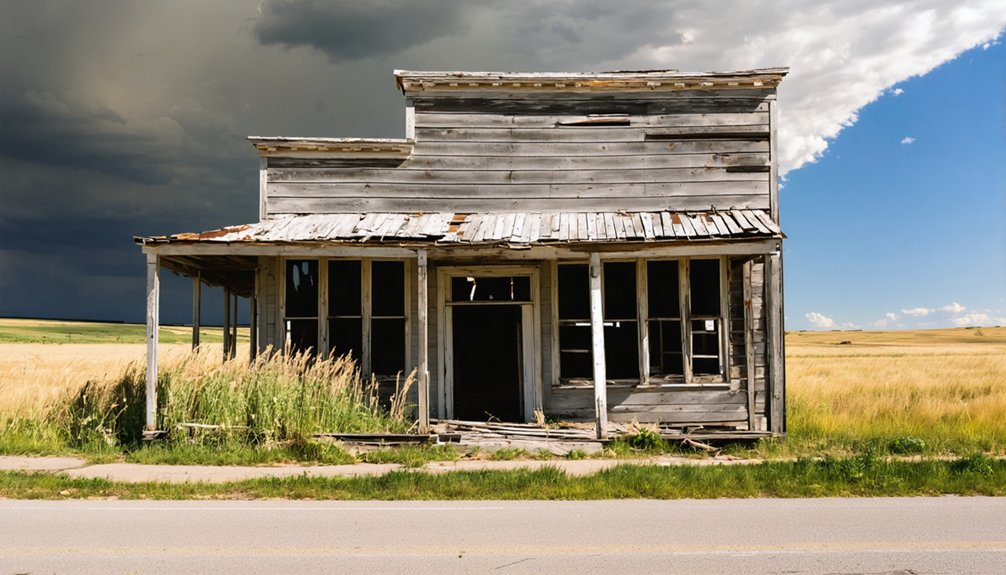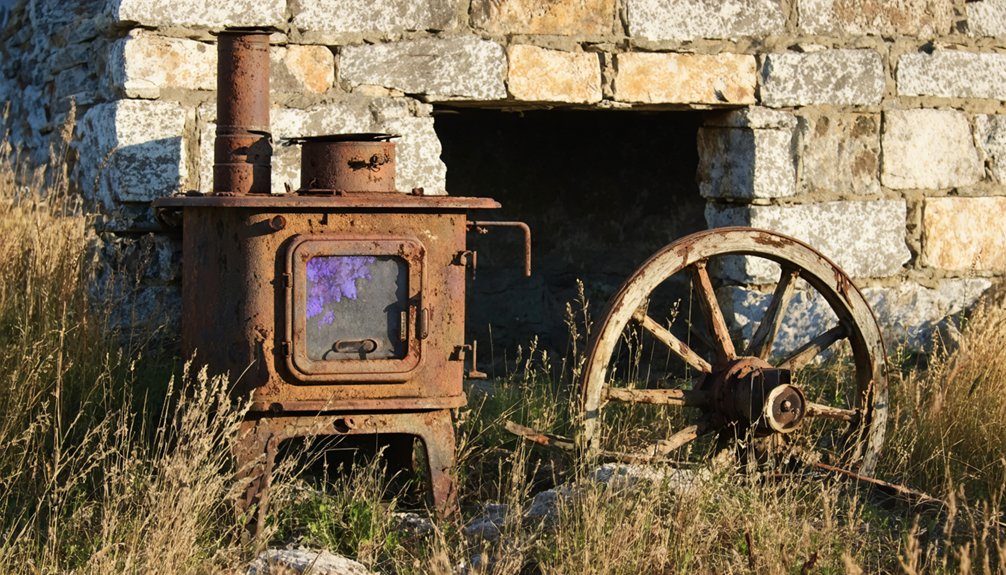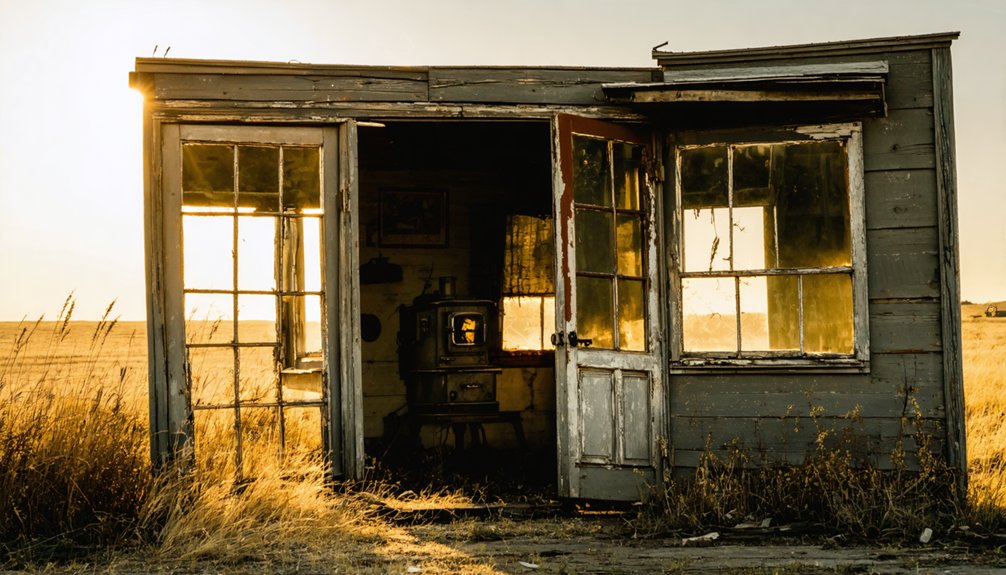You’ll find Centennial City tucked away in South Dakota’s Black Hills, where it emerged during the 1870s gold rush near Deadwood Gulch. At its peak in the early 1900s, this frontier mining town supported nearly 100 residents and produced about $1.5 million in gold through innovative extraction methods. Despite its profitable sawmill and mining operations, the town’s isolation from railroad connections and harsh environmental conditions led to its eventual abandonment. The town’s story reveals much about the boom-and-bust cycle of Black Hills mining settlements.
Key Takeaways
- Centennial City peaked with 100 residents during early 1900s gold mining operations, producing approximately $1.5 million in gold during its height.
- The town relied on stagecoach routes before railroads, but its failure to secure rail connections led to economic isolation.
- Local businesses like Centennial Park Hotel and Draper Roadhouse supported the community before its decline and abandonment.
- Harsh winters, mining hazards, and toxic exposure from gold extraction processes made life challenging for residents.
- The town’s abandonment resulted from depleted gold ore, lost employment, failed railroad connections, and population movement to prosperous areas.
Discovery and Early Settlement
When General George Armstrong Custer led his expedition into the Black Hills in 1874, he inadvertently sparked one of the region’s most significant gold rushes. The discovery near present-day Custer, South Dakota, brought waves of prospectors who defied the Fort Laramie Treaty, forever changing the area’s cultural diversity and social dynamics. A major influx of miners descended upon Deadwood Gulch in 1875, creating a bustling center of activity.
You’ll find that early settlements sprang up quickly around promising mining sites, with prospectors staking claims and establishing makeshift communities in the gulches. The establishment of mining communities evolved as placer miners arrived in 1875, bringing rapid development and growth to the region.
These rapidly evolving camps attracted a mix of miners, entrepreneurs, and families seeking opportunity in the untamed territory. Temporary structures housed essential businesses like saloons, gambling halls, and post offices, while the constant flow of newcomers created a unique blend of backgrounds and experiences that shaped the early Black Hills settlements.
Mining Operations and Gold Rush Era
Three major technological innovations transformed mining operations in Centennial City during the late 19th century: mercury amalgamation, compressed air locomotives, and advanced shaft systems.
These mining techniques revolutionized gold extraction, pushing production to unprecedented levels by the early 1900s. Safety measures including steel-toed shoes became mandatory equipment for all mine workers.
Innovative extraction methods transformed mining operations, driving gold production to record-breaking heights as the 20th century began.
You’ll find that the economic impact was staggering – weekly yields from mines like Holy Terror reached up to $70,000 in the 1890s. The Keystone Mining Company acquired the profitable Keystone Mine in 1893, expanding operations significantly. The region’s population swelled to 5,000 residents as mining wealth fueled development across the Black Hills.
By 1975, operations like the Homestake Mine reached depths beyond 6,800 feet using sophisticated shafts and winzes.
Despite challenges from fires in 1907 and 1919, mining companies continually reinvested in infrastructure, including railroads and timber operations, while achieving gold recovery rates of 94% through innovative cyanidization processes.
Daily Life in a Frontier Town
Beyond the bustling mines and industrial innovations, life in Centennial City centered around basic survival and the gradual development of community infrastructure.
You’d find yourself living in a simple wooden home with a wood-burning stove, hauling water from the local well, and using an outhouse for basic needs. Daily routines revolved around mining work for men, while women managed households and children helped with vital chores.
The general store served as your lifeline, providing essential supplies brought in by rail and wagon. Community gatherings at the saloon, church picnics, and holiday celebrations helped forge bonds among residents. Like many frontier settlements positioned seven miles apart, the town emerged to service steam locomotives on the railroad line. Just as in Mystic, the arrival of the railroad in 1889 brought prosperity and growth to the community.
Despite harsh conditions and cramped living spaces, you’d join mutual aid groups to support neighbors during mining accidents, illnesses, or supply shortages, showcasing the frontier spirit of resilience.
Railroad Connections and Transportation
You’ll find that railroad access proved crucial for frontier town survival in the Black Hills region, where communities either thrived or disappeared based on their rail connections.
When the major rail lines established their routes in 1890-1891, including the Fremont, Elkhorn & Missouri Valley Railroad and the Grand Island & Wyoming Central Railroad, they created essential supply chains for mining operations and settlement growth.
Towns without railroad access often struggled to maintain their populations and economic viability, leading many to become ghost towns as residents relocated to rail-connected communities.
The Burlington Northern railroad operated for nearly a century in the Black Hills, serving as a vital transportation link for both passengers and freight through the region.
The first major rail advancement came in 1885 when the standard gauge railroad reached the Black Hills, establishing a trunk line route from Nebraska to Buffalo Gap and Rapid City.
Railroad Impact on Growth
As Centennial City’s fortunes rose in the late 1800s, the arrival of railroads transformed this Black Hills settlement into a significant transportation hub.
You’ll find that railroad innovation sparked unprecedented economic transformation, as narrow-gauge lines connected the town to essential mining operations in Lead and Deadwood. By the 1890s, standard railroads like the Fremont, Elkhorn & Missouri Valley had integrated the region into larger networks.
The rail station became the heart of commerce and community life. Much like other South Dakota towns, the settlement developed a T-shaped layout with commercial activity concentrated along the tracks.
You’d see agricultural products, mail, and newspapers flowing through these hubs daily. Local businesses thrived with reliable shipping options, while the depot served as a gathering spot for telegrams and informal meetings.
This transportation network proved so crucial that some nearby towns even relocated to secure their railroad connections.
Early Transportation Routes
Before the railroad’s dominance, Centennial City relied on an intricate network of stagecoach routes and freight trails to connect with the wider region.
You’d find early trade routes like the Chamberlain Road, which started at Fort Pierre, bringing essential supplies and merchandise upriver by steamboat before continuing overland to the Black Hills.
The territory’s push for direct routes shaped the region’s development, with local citizens investing in trail construction despite challenging summer freighting conditions in 1882.
If you’d traveled these paths, you’d have followed section lines that formed the basic transportation framework.
A first-class trail proposed from Rapid City to Stage Barn Canyon promised 48-hour travel times to Lead-Deadwood, showcasing the freight logistics that kept commerce flowing before the rails transformed everything.
Decline Without Rail Access
While neighboring towns secured essential railroad connections in the 1880s, Centennial City’s isolation from rail routes sealed its eventual fate.
You’ll find that the town’s transportation isolation effectively cut it off from the regional economic networks that were critical for growth and survival in late 19th century South Dakota.
The consequences of missing out on rail access were severe. Without efficient means to move goods and people, Centennial City faced devastating economic stagnation.
As rail-connected towns attracted businesses, settlers, and investment opportunities, Centennial City’s residents began relocating to these more accessible locations. Like Dakota City’s rapid decline, the town struggled to maintain its population once the railroad bypassed it completely.
The town simply couldn’t compete using wagon and stagecoach routes alone – these slower methods of transport couldn’t match the volume and speed that railroads provided to surrounding communities.
This competitive disadvantage ultimately led to the town’s abandonment.
Peak Years and Economic Prosperity
You’ll find Centennial City reached its zenith in the early 1900s when hard rock mining operations and profitable gold extraction drew nearly 100 residents to this bustling mountain community.
The town’s economic backbone consisted of a sawmill that operated until 1952, alongside multiple mining operations that utilized cyanide milling technology to process valuable ore deposits.
Local businesses, including a chapel and various merchants, thrived during this period as the railroad networks facilitated steady commerce and efficient mineral transport to distant markets.
Mining Operations and Profits
During the late 19th century, Centennial City emerged as a thriving mining hub that generated approximately $1.5 million in gold production during its peak years.
You’ll find that mining profits fueled rapid growth, as operations evolved from simple placer mining to sophisticated hardrock extraction methods. By 1888, the Golden Reward chlorination plant revolutionized the area’s processing capabilities, allowing miners to profitably extract gold from even low-grade ore.
While operational challenges included varying ore quality and increasing mining depths, companies like Homestake Mining adapted and thrived. They built their own railroad, controlled crucial resources along Whitewood Creek, and reinvested profits into infrastructure.
Despite occasional land disputes with residents, the industry’s success transformed Centennial City into a regional economic powerhouse, spurring development in nearby towns and commerce.
Population Boom Years
The population surge in Centennial City directly mirrored its mining prosperity, with the town’s most dramatic growth occurring between 1878 and 1887.
You’ll find this timing aligned perfectly with the Great Dakota Boom, when the territory’s population exploded from 60,000 to over 500,000 residents.
The town’s population demographics reflected the era’s typical migration patterns, dominated by young male miners and railroad workers seeking their fortunes.
As the railroad reached the area, it brought waves of homesteaders and their families, transforming the community’s composition.
The peak years stretched into the early 1900s, supported by the town’s mining operations and rail connections.
Like many South Dakota boomtowns, though, Centennial City’s prosperity wouldn’t last beyond 1920, when declining mining activity triggered a population exodus.
Local Business Success Stories
When prosperity peaked in Centennial City between 1878 and 1890, several pioneering businesses emerged as cornerstones of the local economy.
The Centennial Park Hotel and Post Office established itself as a crucial stage stop, fostering local commerce between Spearfish and Deadwood until 1883. After its destruction by fire, the innovative Draper Roadhouse took its place in 1888, featuring modern indoor plumbing that showcased the town’s entrepreneurial spirit.
Henry Frawley’s ranch enterprise exemplified the diversification of the economy, with his distinctive stone courtyard barns and premium livestock breeding program.
The steady flow of miners, travelers, and freight companies supported a thriving network of mercantile stores, blacksmiths, and hospitality services, creating a robust micro-economy that would define Centennial City’s golden years.
Architecture and Infrastructure
Mining-era architecture in Centennial City featured a practical mix of residential, commercial, and industrial structures that defined this late 19th-century frontier settlement.
You’ll find the urban design followed typical patterns, with buildings clustered around mine shafts and railroad access points. Victorian Gothic elements adorned the more prominent structures, particularly banks and wealthy residents’ homes, while miners’ cabins and boarding houses maintained simpler designs using local stone foundations.
The town’s industrial backbone is evident in the architectural preservation of large mills, shaft houses, and distinctive cyanide vats.
These industrial remnants showcase the engineering ingenuity of the era, with elevated tramways and ore processing facilities strategically positioned near mine openings. The infrastructure included essential services like post offices and stage stations, though water and sanitation systems remained basic throughout the town’s existence.
Natural Challenges and Hardships

If you’d visited Centennial City in the late 1800s, you would’ve witnessed miners battling brutal winters with temperatures plummeting below -30°F, forcing many to abandon their claims during the harshest months.
The hazardous nature of mining operations became evident through frequent accidents, including cave-ins and equipment failures that claimed numerous lives between 1876 and 1890.
Working deep within the Black Hills’ mines exposed prospectors to toxic gases, unstable shafts, and flooding, which, combined with limited medical care in the remote location, made survival particularly challenging.
Harsh Winter Survival
Throughout the bitter winters of South Dakota’s Centennial City, residents faced a relentless battle against nature’s harshest elements. You’d find winter survival meant confronting subzero temperatures that could plummet well below zero Fahrenheit, while snow piled several feet deep, isolating the town from essential supply routes and neighboring settlements.
Your cold resilience would’ve been tested daily in makeshift shelters – from basic log cabins to crude wooden structures offering minimal protection. You’d struggle to maintain heat using temperamental wood stoves, while battling poor ventilation and constant fire risks.
The scarcity of food and medical supplies meant you’d rely heavily on preserved goods and whatever game you could hunt through deep snowdrifts. Transportation nearly ceased as railroads and wagon trails became impassable, leaving you to endure weeks of isolation in the frozen frontier.
Mining Hazards and Accidents
Deep beneath Centennial City’s surface, miners faced a lethal array of hazards that claimed numerous lives throughout the settlement’s peak years.
You’d find mining safety was often compromised by unstable geology, with sudden rock collapses and flooding in poorly supported tunnels. The greatest threats came from explosive risks during ore extraction, where powder keg accidents and unplanned detonations could trigger catastrophic chain reactions throughout the interconnected shaft system.
Toxic gases posed another deadly challenge, as primitive ventilation couldn’t prevent the buildup of methane and carbon monoxide.
Equipment failures involving rail cars, hoists, and crushers regularly injured or killed workers, while long-term exposure to cyanide and mercury used in gold processing left lasting health impacts on those who survived the immediate dangers underground.
Factors Leading to Abandonment
While Centennial City once thrived as a bustling Black Hills mining settlement, several interconnected factors led to its eventual abandonment in the early 20th century. The depletion of gold ore triggered a devastating economic decline, eliminating the town’s primary source of employment and investment.
Transportation issues compounded the problem when the town failed to secure essential railroad connections, leaving it isolated from major trade routes.
Harsh environmental conditions, including severe winters and flooding, made it difficult for residents to sustain themselves once mining ceased. The lack of agricultural potential prevented economic diversification, while environmental damage from mining operations left the landscape unsuitable for alternative uses.
These challenges sparked significant demographic shifts as residents moved to more prosperous areas, and attempts to pivot toward tourism proved unsuccessful in maintaining the town’s population.
Remnants and Archaeological Findings

Today’s visitors to the former Centennial City site encounter a landscape shaped by decades of abandonment and natural reclamation.
While specific archaeological findings remain limited, the area holds potential archaeological significance due to its proximity to historically rich regions like Deadwood. Native vegetation has gradually overtaken what remains of the settlement’s structures and roads.
The site’s material culture could reveal valuable insights about early South Dakota life, particularly through possible discoveries of tool stones, ceramics, and lithic tools common to the region.
You’ll find that preservation efforts face ongoing challenges due to environmental factors and the remote location. Despite these obstacles, the site’s cultural artifacts could provide essential information about the area’s past inhabitants and their way of life, though formal archaeological studies have yet to be conducted.
Historical Legacy in the Black Hills
The discovery of gold in the Black Hills during Custer’s 1874 expedition sparked a transformative era that would forever alter the region’s cultural and economic landscape.
When you explore Centennial City’s past, you’ll find it deeply intertwined with the complex legacy of the Black Hills gold rush, which disrupted the sacred lands of the Lakota Sioux protected by the Fort Laramie Treaty of 1868.
The area stands as a symbol to both the boom-and-bust cycle of mining settlements and the enduring cultural resilience of indigenous heritage.
While the mining operations that birthed Centennial City have long since vanished, the site remains a powerful reminder of the clash between Native American rights and American expansion, contributing to the broader historical narrative that defines the Black Hills today.
Frequently Asked Questions
Are There Any Documented Paranormal Activities or Ghost Sightings in Centennial City?
You won’t find documented ghost sightings or paranormal investigations here – records show zero reported supernatural activity, setting it apart from South Dakota’s famously haunted locations like Galena and Deadwood’s historic sites.
What Happened to the Cemetery and Graves of Original Settlers?
You’ll find the original settlers’ resting places have moved on – their cemetery stone now stands at Brown County Centennial Village, while the burial sites themselves have faded into time’s embrace.
Did Any Notable Outlaws or Criminals Ever Hide in Centennial City?
You won’t find solid proof of outlaw legends or criminal hideouts here – while nearby Deadwood attracted notorious characters, there’s no historical evidence that any famous outlaws used this remote settlement.
Were Any Significant Native American Artifacts Found in the Town Area?
While you’d expect major finds in this Black Hills region, there’s no confirmed record of significant native artifacts within Centennial City itself, though stone tools and pottery fragments exist nearby.
What Modern Ownership Disputes or Land Claims Exist Over Centennial City?
You’ll find ongoing disputes between ranchers and federal agencies over historical claims and land ownership boundaries, especially concerning fence lines and grazing rights established by early settlers in the Centennial Valley area.
References
- https://www.sdhspress.com/journal/south-dakota-history-2-2/some-black-hills-ghost-towns-and-their-origins/vol-02-no-2-some-black-hills-ghost-towns-and-their-origins.pdf
- https://www.sdpb.org/rural-life-and-history/2023-08-21/some-black-hills-ghost-towns-and-their-origins
- https://www.youtube.com/watch?v=Glucs_Rq8Xs
- https://www.powderhouselodge.com/black-hills-attractions/fun-attractions/ghost-towns-of-western-south-dakota/
- https://www.southdakotamagazine.com/1880-town
- https://www.youtube.com/watch?v=_0WNYsFLSLA
- https://www.blackhillsbadlands.com/blog/post/old-west-legends-mines-ghost-towns-route-reimagined/
- http://files.usgwarchives.net/sd/bonhomme/history/spghost.txt
- https://www.deadwood.com/history/history-timeline/
- https://tranquiltrekker.com/tag/centennial-trail/



